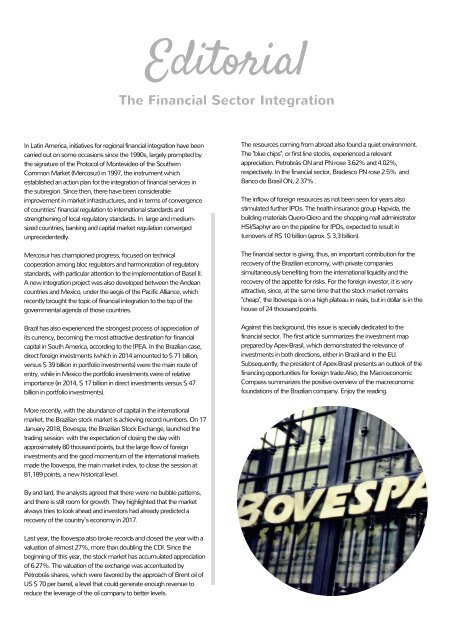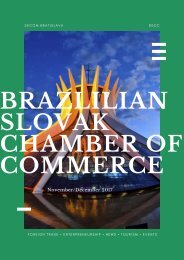Cópia de Brazlilian Slovak Chamber of Commerce (4)
You also want an ePaper? Increase the reach of your titles
YUMPU automatically turns print PDFs into web optimized ePapers that Google loves.
Editorial<br />
The Financial Sector Integration<br />
In Latin America, initiatives for regional financial integration have been<br />
carried out on some occasions since the 1990s, largely prompted by<br />
the signature <strong>of</strong> the Protocol <strong>of</strong> Montevi<strong>de</strong>o <strong>of</strong> the Southern<br />
Common Market (Mercosur) in 1997, the instrument which<br />
established an action plan for the integration <strong>of</strong> financial services in<br />
the subregion. Since then, there have been consi<strong>de</strong>rable<br />
improvement in market infrastructures, and in terms <strong>of</strong> convergence<br />
<strong>of</strong> countries' financial regulation to international standards and<br />
strengthening <strong>of</strong> local regulatory standards. In large and mediumsized<br />
countries, banking and capital market regulation converged<br />
unprece<strong>de</strong>ntedly.<br />
Mercosur has championed progress, focused on technical<br />
cooperation among bloc regulators and harmonization <strong>of</strong> regulatory<br />
standards, with particular attention to the implementation <strong>of</strong> Basel II.<br />
A new integration project was also <strong>de</strong>veloped between the An<strong>de</strong>an<br />
countries and Mexico, un<strong>de</strong>r the aegis <strong>of</strong> the Pacific Alliance, which<br />
recently brought the topic <strong>of</strong> financial integration to the top <strong>of</strong> the<br />
governmental agenda <strong>of</strong> those countries.<br />
Brazil has also experienced the strongest process <strong>of</strong> appreciation <strong>of</strong><br />
its currency, becoming the most attractive <strong>de</strong>stination for financial<br />
capital in South America, according to the IPEA. In the Brazilian case,<br />
direct foreign investments (which in 2014 amounted to $ 71 billion,<br />
versus $ 39 billion in portfolio investments) were the main route <strong>of</strong><br />
entry, while in Mexico the portfolio investments were <strong>of</strong> relative<br />
importance (in 2014, $ 17 billion in direct investments versus $ 47<br />
billion in portfolio investments).<br />
The resources coming from abroad also found a quiet environment.<br />
The "blue chips", or first line stocks, experienced a relevant<br />
appreciation. Petrobrás ON and PN rose 3.62% and 4.02%,<br />
respectively. In the financial sector, Bra<strong>de</strong>sco PN rose 2.5% and<br />
Banco do Brasil ON, 2.37% .<br />
The inflow <strong>of</strong> foreign resources as not been seen for years also<br />
stimulated further IPOs. The health insurance group Hapvida, the<br />
building materials Quero-Qiero and the shopping mall administrator<br />
HSI/Saphyr are on the pipeline for IPOs, expected to result in<br />
turnovers <strong>of</strong> R$ 10 billion (aprox. $ 3,3 billion).<br />
The financial sector is giving, thus, an important contribution for the<br />
recovery <strong>of</strong> the Brazilian economy, with private companies<br />
simultaneously benefiting from the international liquidity and the<br />
recovery <strong>of</strong> the appetite for risks. For the foreign investor, it is very<br />
attractive, since, at the same time that the stock market remains<br />
"cheap", the Ibovespa is on a high plateau in reais, but in dollar is in the<br />
house <strong>of</strong> 24 thousand points.<br />
Against this background, this issue is specially <strong>de</strong>dicated to the<br />
financial sector. The first article summarizes the investment map<br />
prepared by Apex-Brasil, which <strong>de</strong>monstrated the relevance <strong>of</strong><br />
investments in both directions, either in Brazil and in the EU.<br />
Subsequently, the presi<strong>de</strong>nt <strong>of</strong> Apex-Brasil presents an outlook <strong>of</strong> the<br />
financing opportunities for foreign tra<strong>de</strong>.Also, the Macroeconomic<br />
Compass summarizes the positive overview <strong>of</strong> the macreconomic<br />
foundations <strong>of</strong> the Brazilian company. Enjoy the reading.<br />
More recently, with the abundance <strong>of</strong> capital in the international<br />
market, the Brazilian stock market is achieving record numbers. On 17<br />
January 2018, Bovespa, the Brazilian Stock Exchange, launched the<br />
trading session with the expectation <strong>of</strong> closing the day with<br />
approximately 80 thousand points, but the large flow <strong>of</strong> foreign<br />
investments and the good momentum <strong>of</strong> the international markets<br />
ma<strong>de</strong> the Ibovespa, the main market in<strong>de</strong>x, to close the session at<br />
81,189 points, a new historical level.<br />
By and lard, the analysts agreed that there were no bubble patterns,<br />
and there is still room for growth. They highlighted that the market<br />
always tries to look ahead and investors had already predicted a<br />
recovery <strong>of</strong> the country's economy in 2017.<br />
Last year, the Ibovespa also broke records and closed the year with a<br />
valuation <strong>of</strong> almost 27%, more than doubling the CDI. Since the<br />
beginning <strong>of</strong> this year, the stock market has accumulated appreciation<br />
<strong>of</strong> 6.27%. The valuation <strong>of</strong> the exchange was accentuated by<br />
Petrobrás shares, which were favored by the approach <strong>of</strong> Brent oil <strong>of</strong><br />
US $ 70 per barrel, a level that could generate enough revenue to<br />
reduce the leverage <strong>of</strong> the oil company to better levels.



